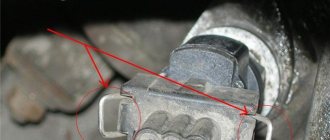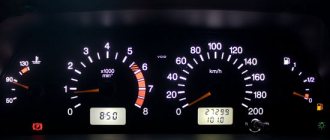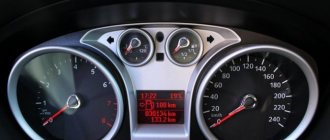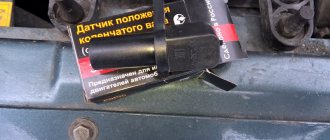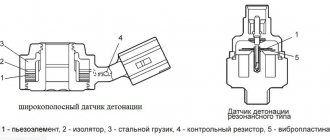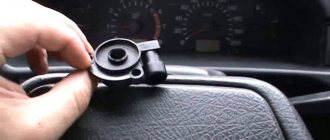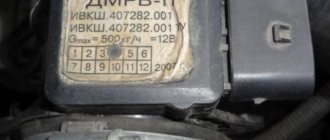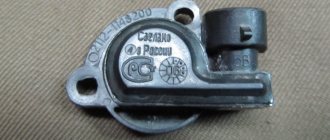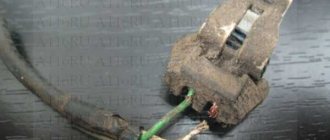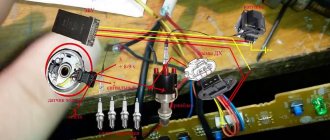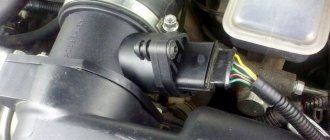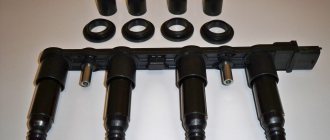A vehicle speed sensor (VS) is necessary to measure the speed of a vehicle. The readings from the sensor are transmitted to the electronic control unit (ECU), which controls the engine and adjusts engine operation. On the vast majority of cars, the speed sensor is located directly on the gearbox, closer to the speedometer drive mechanism.
Among the main malfunctions of the DSA are: open circuits, damage or oxidation of contacts, failure of the sensor itself, malfunction of the speed sensor drive. If malfunctions occur, the speed sensor is checked with and without dismantling:
- multimeter (measuring signals within the operating cycle);
- using a control lamp;
Detailed information about the signs of a malfunctioning speed sensor, as well as how to check it, is presented in our article.
Speed sensor on a car: where is it located?
The speed sensor is located on the gearbox, in the area of the speedometer drive mechanism. The main task of the vehicle speed sensor (VS) is to measure speed, after which this information is transmitted to the ECU.
Having received a signal from the DSA, the electronic unit regulates the idle speed, controls the amount of air entering the engine, and also changes a number of other parameters. The faster the car moves, the higher the frequency of the signals transmitted from the speed sensor.
Operating principle of the sensor
In most cars with a manual transmission, the speed sensor is installed in the area of the gearbox; if we consider a car with an automatic transmission (and not only), it is located closer to the output shaft of the box, and its task is to record the rotation speed of the specified shaft.
To deal with the problem and understand why the speed sensor (DS) is faulty, the first thing you need to understand is the principle of its operation. This is best done using the example of the popular domestic car VAZ-2114, since, according to statistics, it is on this car that speed sensors most often break down.
Speed sensors operating on the basis of the Hall effect generate a pulse signal, which is transmitted via a signal wire to the ECU. The faster the car goes, the more often impulses are transmitted. On a VAZ 2114, the number of pulses per kilometer is 6004. The speed of their formation depends on the speed of rotation of the shaft. There are two types of electronic sensors - with and without shaft contact. However, nowadays, as a rule, it is contactless sensors that are used, since their design is simpler and more reliable, so they have widely replaced older modifications of speed sensors.
To ensure the operation of the DS, it is necessary to place a master (pulse) disk with magnetized sections on the rotating shaft (bridge, gearbox, gearbox). When passing these areas near the sensitive element of the sensor, corresponding impulses will be generated in the latter, which will be transmitted to the electronic control unit. The sensor itself and the chip with the magnet are motionless.
Most cars equipped with an automatic transmission have two shaft rotation sensors installed on its components - primary and secondary. Accordingly, the speed of the vehicle is determined by the speed of rotation of the secondary shaft, therefore another name for the automatic transmission speed sensor is secondary shaft sensor . Typically, these sensors operate on the same principle, but have design features, so in most cases their mutual replacement is impossible. The use of two sensors is due to the fact that, based on the difference in the angular speeds of rotation of the shafts, the ECU makes a decision to switch the automatic transmission to one gear or another.
The speed sensor has failed: signs of a malfunction
An obvious sign of problems with the DSA is a non-functioning speedometer. If a fuel-injected engine stalls at idle or during transient operation, the vehicle speed sensor may also be the cause.
In cases where the speed sensor (speedometer sensor) is completely out of order or transmits incorrect data, the power unit operates extremely unstable.
If such malfunctions occur in the motor, you should pay attention to signs of a malfunction of the speed sensor, and it is also necessary to check the speed sensor (can be done by yourself).
At the initial stage, it is important to determine that the speed sensor is not working and the cause of engine malfunction is a breakdown of the DSA. You should pay attention to the following signs of a malfunctioning speedometer sensor:
- in XX mode the engine is unstable;
- when the vehicle is moving, the speedometer does not work or the readings are incorrect;
- traction is lost, engine power is greatly reduced;
- the car accelerates jerkily, dips are noticeable during acceleration;
- When you release the gas pedal after accelerating the car, jerks are observed;
- fuel consumption is greatly increased
Also, “check” should usually light up on the instrument panel, and the error is recorded in the ECU memory in the form of a corresponding code. Please note that on some cars the “check” may not light up. There have also been cases when the car’s BC conducts self-diagnosis and displays the error “no DSA signal.”
In what cases is replacement required?
DS is a part that does not change very often, this is due to the reliability of the device, which lies in its simple design. Before changing it, you need to make sure that there is a malfunction, because the signs may indicate completely different problems.
The procedure for replacing the speed sensor does not take much time and does not require so much effort, so many people try to carry out this procedure on their own. Follow the order of procedure:
- The battery must be disconnected from the on-board grid, only then disconnect the speed sensor. In this case, two keys are used - “10” and “21”. Although a lot depends on the make of the car.
- The sensor itself is unscrewed, but this must be done carefully, because the rod may be damaged, and then the procedure will become more complicated. It is necessary to purchase the same part with an equal number of teeth on the gear.
- The process of installing a new element is carried out in reverse order. A rod is installed in the sensor sleeve, then an o-ring, which is pre-treated with oil, and finally the device is fixed in its place.
After installing a new DS, it is necessary to reset the ECU errors, otherwise the car will not consider the replacement effective. How to do this - see the example of VW Passat:
What to pay attention to
When carrying out the procedure for replacing the speed sensor, you must turn off the ignition. After all, if there is voltage in the circuit, and you connect a voltmeter, a short circuit may occur, then the remaining elements will definitely fail.
When removing the DS, you may encounter rod defects, so you should dismantle the speedometer drive. The drive is removed using a wrench; it is important to carry out the procedure carefully, removing it from the manual transmission body. Don't miss the rod near the gearbox.
Now everyone can appreciate the importance of DC, which not only indicates speed, but also affects the engine. Therefore, it is important to correct the malfunction in a timely manner, and sometimes resort to replacing the sensors.
6 best thickness gauges for 2022
8 Best G12 class antifreezes
TOP 9 best antifreezes for 2022
How to drain gasoline from the tank of any car
Big test dextron or which one is better to pour
The speedometer sensor does not work: reasons
DSA malfunctions are usually caused by open circuits, damaged or oxidized contacts.
Structurally, the car speed sensor itself is quite reliable (considering the speed sensor, the device circuit is quite simple).
It is also important to consider the fact where the speed sensor is located. The location in the engine compartment at the gearbox does not prevent oil contamination, ingress of technical fluids, water and dirt, etc.
- At the initial stage, it is necessary to check the wiring and contacts for integrity. As for the contacts, it is necessary to clean and lubricate them (Litol type lubricant is suitable);
- The wires to the speed sensor usually break near the plug at the bend, as the wiring frays and the insulation cracks;
- At the same time, it is recommended to check the resistance in the grounding circuit. The norm is 1 Ohm.
If no wiring or contact defects are found or the methods discussed above do not resolve the problem, you need to check the speed sensor for functionality.
How to check the speed sensor yourself
Among the main ways to check DSA are:
- checking with a voltmeter;
- diagnostics using a control lamp;
Many cars have a sensor whose operation is based on the Hall effect. It is not difficult to check this type of DSA. However, there are other types of speed sensors: reed sensor, as well as inductive speed sensor. The method for testing such sensors is somewhat different.
Checking the speed sensor with a multimeter
The most common type of speed sensor has 3 contacts: pulse, ground and voltage. First of all, you need to determine the presence of grounding and 12V voltage on the contacts.
These contacts are checked with a multimeter, while the “pulse” contact is checked by rotating. Normally, the voltage between the pin and ground should be from 0.5V to 10V.
To check the speed sensor with a voltmeter you will need:
- remove the speed sensor;
- determine the purpose of contacts;
- switch the multimeter to voltmeter mode;
- connect the incoming contact to the output;
- ground the second contact to the engine (can be to the car body);
Then the speed sensor must be rotated, determining the presence or absence of signals in the work cycle. The output voltage of the sensor is also measured. To do this, it is recommended to put a piece of tube on the sensor axis and rotate it at a low speed of up to 5 km/h. The faster the sensor rotates, the higher the voltage on the voltmeter should be.
How to check the speedometer sensor without removing it
If the owner does not know how to remove the speed sensor from the car or intends to do a quick check, you can do without removing the sensor. For such a check you will need:
- raise the car on a jack so that one drive wheel comes off the ground and rotates freely;
- Next, the sensor contacts are connected to a voltmeter. Then you need to rotate the wheel and determine whether voltage appears, and whether there is a change in frequency;
If the voltage is fixed and the frequency changes, the speed sensor is working. In the case when there is no voltage, there is a high probability of failure of this element.
Quick check of the speedometer sensor with a test light
Checking the speed sensor can also be done using a warning light (or so-called control light). As part of such a check:
- The pulse wire is disconnected from the sensor;
- the car is lifted on a jack;
- one wheel is hung out and the ignition is turned on;
- then one control wire is powered to the “+” battery;
- the second wire will be connected to the “signal” connector;
If the light blinks while the wheel is rotating, the speed sensor is working. If the lamp does not blink, it will indicate that the sensor is faulty and requires replacement.
Diagnostics
Troubleshooting begins by disconnecting the wiring block from the speed sensor harness and checking them using a test light.
To make a control light bulb, you need any car lamp that can operate at a voltage of 12 V, and two wires about 1 meter long each. One of the wires is attached to the positive terminal, the second - to the negative terminal of the lamp. The resulting device also includes a Krona battery.
To carry out the test, one wire of the warning lamp is attached to the ground of the body or battery, and the second is made with short, frequent touches to the middle contact of the DC connector. If there are no faults in the connector-speedometer section, the speedometer needle will slightly tremble or rise. If the needle shakes, the answer to the question why the speedometer does not work can be considered found - the speed sensor requires replacement.
In cases where the needle’s response to tapping on the central contact of the block cannot be detected, it is necessary to “test” the speedometer power circuit. The procedure is carried out using a multimeter (multitester), or by using the same light bulb - a control.
If the tester in the “continuity” mode indicates a violation of the integrity of the circuit, further troubleshooting is carried out in this direction. It is necessary to check the fuses, the connection points of the wires, and their integrity inside the insulating braid.
How to check the speed sensor drive
In some cases, the cause of the malfunction may also be not the sensor itself, but its drive. For this reason, it is also recommended to check the speedometer sensor drive. For such a check you will need:
- jack up the car and hang out the wheel;
- detect the sensor drive coming out of the gearbox;
- rotate the wheel (you can use your foot yourself or have an assistant);
While the wheel is rotating, you need to tactilely evaluate the quality of the drive (feel it with your fingers). It is important not only to make sure that the drive works, but also how stable its overall operation is.
We also recommend reading the article about the signs of a malfunction of the IAC idle air regulator. In this article you will learn about ways to check the idle speed control.
As a rule, any deviations from the norm are grounds for disassembling the drive. Often the teeth on the speed sensor drive gears are damaged.
Other types of speed sensors: reed switch type and induction type sensor
Although such sensors are used much less frequently than Hall effect sensors, such solutions are found on some cars. For this reason, it is necessary to take into account some features.
- A sensor with a reed switch produces signals in the form of rectangular pulses with a cycle of 40-60%, while switching is carried out from 0 to 5V or from 0 to battery voltage 12V.
- As for the induction sensor, the signal from the rotation of the wheels is similar to a wave oscillation (wave impulse). As a result, the voltage changes based on the rotation speed. The principle itself is similar to the operation of the crankshaft angle sensor.
Diagram and pinout of DS Priora
Three wires are connected to the DS Priora plug. One of them is positive 12V, the second or central one is the signal wire that supplies impulses to the control unit, and the third is ground.
The speed sensor power supply circuit is shown in the photo below.
The DS pinout diagram on a Priora may be needed when replacing a plug or checking the incoming power.
Let's sum it up
The speed sensor (speedometer sensor) is an important element in the electronic engine control system. If the driver notices the signs of engine malfunctions discussed in the article, special attention should be paid to the vehicle speed sensor.
We also recommend reading the article about what a phase sensor is. From this article you will learn about the signs of a faulty phase sensor, as well as how to check it.
In addition to checking other sensors (mass air flow sensor, speed sensor, speed sensor, etc.), it is also necessary to diagnose the speed sensor. The reason is that the failure of one or another sensor will not always be accompanied by the lighting of the “check engine” warning light on the instrument panel. As a result, in-depth diagnostics are required.
Description of DS
As we have already said, the main purpose of the speedometer drive sensor is to accurately determine the speed of the vehicle. Thanks to this device, the model can always know at what speed his car is moving. As for the varieties, DS can be of the contact or non-contact type. Today, most of our compatriots prefer contactless options. Contact DS, despite all the advantages, have one significant drawback - they are prone to contamination, which in turn will lead to inaccuracy of the displayed readings.
Design and principle of operation
Structurally, according to the diagram, this part consists of:
- speedometer drive;
- housings;
- as well as the controller itself with a connector for connecting to the on-board network.
As for the principle of operation, it is based on measuring the frequency level of signals from the controller, which is located on the gearbox housing or transfer case. At the output of the device, while driving, rectangular pulses are formed, the minimum value of which should be at least 1 volt, and the maximum value should be at least 5 volts.
According to international standards, the controller must generate about 6 thousand such pulses over one kilometer. The pulses themselves are subsequently converted into current, which is measured by a magnetoelectric device. It should be noted that the current value directly depends on the number of signals supplied per certain unit of time. That is, this value will be directly proportional to the speed of the vehicle.
In addition, thanks to the electronic circuit installed in the dashboard, the operation of the stepper motor is ensured by counting incoming signals. The latter is designed to rotate the counter reels, after which it displays the relevant information on a small screen, where the total and daily mileage of the car is shown. If we are talking about daily mileage, then this value can be reset to zero if necessary.
Symptoms of a problem
If the DS for some reason fails, this will lead to the control unit being unable to determine the speed of movement. However, this is not the only problem, since malfunctions in the performance of the power unit may also occur.
We suggest that you familiarize yourself in more detail with the signs of a malfunction, by which you can determine the failure of the DS:
- the speedometer on the dashboard has either stopped working altogether or displays incorrect readings;
- malfunctions appear in engine operation, in particular at idle speed;
- fuel consumption increased;
- engine performance has deteriorated, the power unit cannot reach the required speed;
- the engine may stop spontaneously while idling, in particular when the driver tries to press the clutch to change gear;
- if the car is equipped with an on-board computer, a Check indicator may appear on the dashboard;
- if the car is equipped with an electric power steering, this unit may also fail;
- in some cars, for example, Lada Kalina, failure of the diesel engine can also lead to increased sensitivity of the fuel level controller in the gas tank (the author of the video is the Autoelectrics HF channel).
